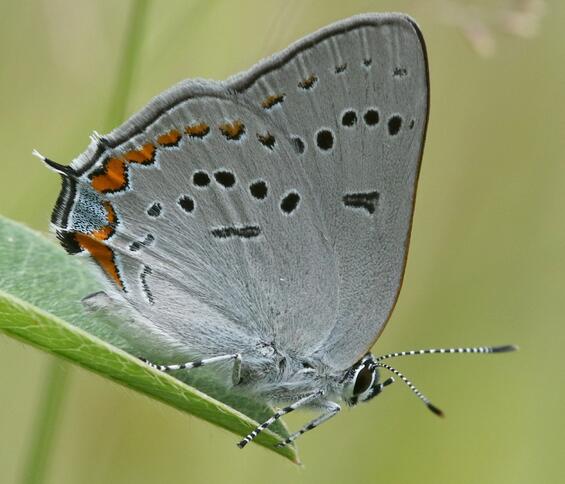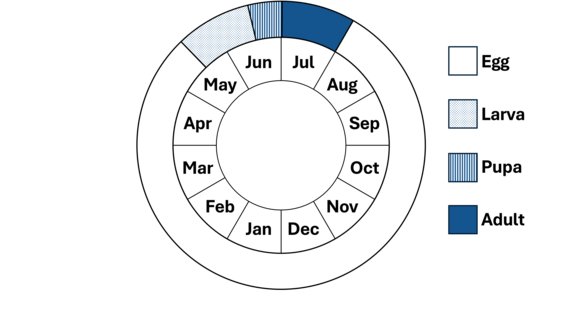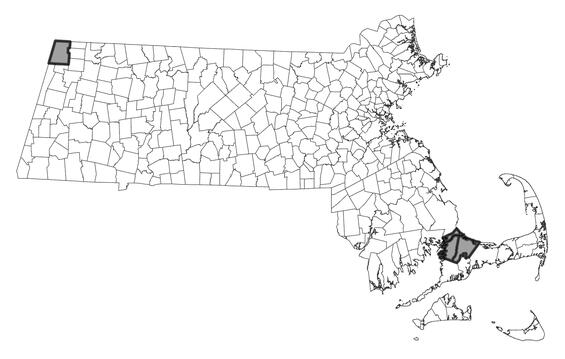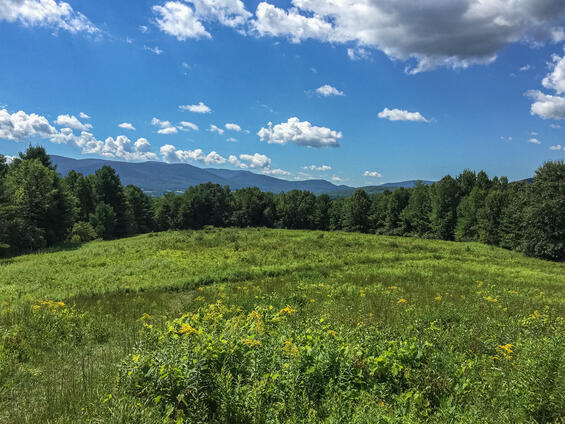- Scientific name: Satyrium acadica
- Species of Greatest Conservation Need (MA State Wildlife Action Plan)
- Threatened (MA Endangered Species Act)
Description

Acadian hairstreak (Satyrium acadica), image by Garry Kessler.
The Acadian hairstreak (Satyrium acadica) is a lycaenid butterfly with a wingspan of 30-36 mm (1.2-1.4 in). Like most gossamer-wings, the Acadian hairstreak rests with wings folded above its back. The upper side of the wings, hidden in this position, are uniformly brownish gray with an orange spot at the base of each tailed hind wing. The undersides of the wings are light gray with a submarginal row of white-ringed, round black spots and a marginal row of black-capped, orange spots culminating with a blue spot at the base of each hind wing near the tail. The submarginal row of round, well separated, black spots with white borders is unique among northeastern hairstreak butterflies.
Life cycle and behavior

In Massachusetts, the Acadian hairstreak flies in July, with early individuals in late June and stragglers in early August. Adult butterflies nectar at flowers such as milkweeds (Asclepias spp.), dogbanes (Apocynum spp.), thistles (Cirsium spp.), meadowsweet (Spirea alba) and New Jersey tea (Ceanothus americanus). Larvae feed on willows (Salix spp.). There is one brood per year, with eggs overwintering and hatching in the spring.
Distribution and abundance
The Acadian hairstreak is a northern species, ranging from Nova Scotia south to New Jersey, and west to Montana and Colorado (Opler 1998, 1999). Formerly found across most of the state, this species has been declining in Massachusetts for at least two decades. Recent records are known from only two sites in state.

Distribution in Massachusetts.
1999-2024
Based on records in the Natural Heritage Database.
Habitat
In Massachusetts, the Acadian hairstreak inhabits open areas in or near wetlands with both willows (Salix) for larvae and wildflowers for adults. These habitats include wet meadows, marshes, shrub swamps, and stream margins.
Healthy habitats are vital for supporting native wildlife and plants. Explore habitats and learn about conservation and restoration in Massachusetts.

Meadow habitat with wildflowers that provide nectar for the Acadian hairstreak butterfly. Habitat managed by The Trustees at Mountain Meadow Preserve. Photo courtesy of The Trustees.
Threats
The Acadian hairstreak is threatened by habitat loss and hydrologic alteration that disrupts its wetland and wetland edge habitat. Other potential threats include invasion by exotic plants, eutrophication or other water pollution, introduced generalist parasitoids, aerial insecticide spraying, non-target herbicide application, and excessive deer browse of host plants. The Acadian hairstreak is vulnerable to climate change, as it is a northern species with a range that extends south only to New Jersey.
Conservation
Land protection and habitat management are the primary conservation needs of the Acadian hairstreak in Massachusetts. In particular, wet meadows, marshes, shrub swamps, and stream margins should be conserved, restored, and managed to maintain habitat for this species and other species dependent on such habitats.
Survey and monitoring
The distribution of the Acadian hairstreak in Massachusetts is well documented. As this species is declining in the state, appropriate habitat should continue to be surveyed to better document this trend. Known populations should be surveyed to document persistence at least once every 25 years; every 10 years is more desirable when practicable.
Management
Management of wetlands and adjacent wet areas such as wet meadows, marshes, shrub swamps, and stream margins benefits a diversity of species. For the Acadian hairstreak, open areas with both willows for larvae and wildflowers for adults are of particular importance. Restoration and maintenance of natural hydrology and control of invasive exotic plants are of primary importance. Habitat condition should be monitored and management adapted as needed.
Research needs
The natural history and conservation needs of the Acadian hairstreak are relatively well known. However, the specific species of willows used as larval host plants in Massachusetts remain undocumented. The decline of this species in Massachusetts may be a result of climate change; this and other threats driving the decline should be studied.
References
Opler, P.A. 1998. A Field Guide to Eastern Butterflies. Peterson Field Guide Series. Houghton Mifflin, Boston, Massachusetts. 486 pp.
Opler, P.A. 1999. A Field Guide to Western Butterflies. Peterson Field Guide Series. Second edition. Houghton Mifflin, Boston, Massachusetts. 540 pp.
Contact
| Date published: | March 26, 2025 |
|---|